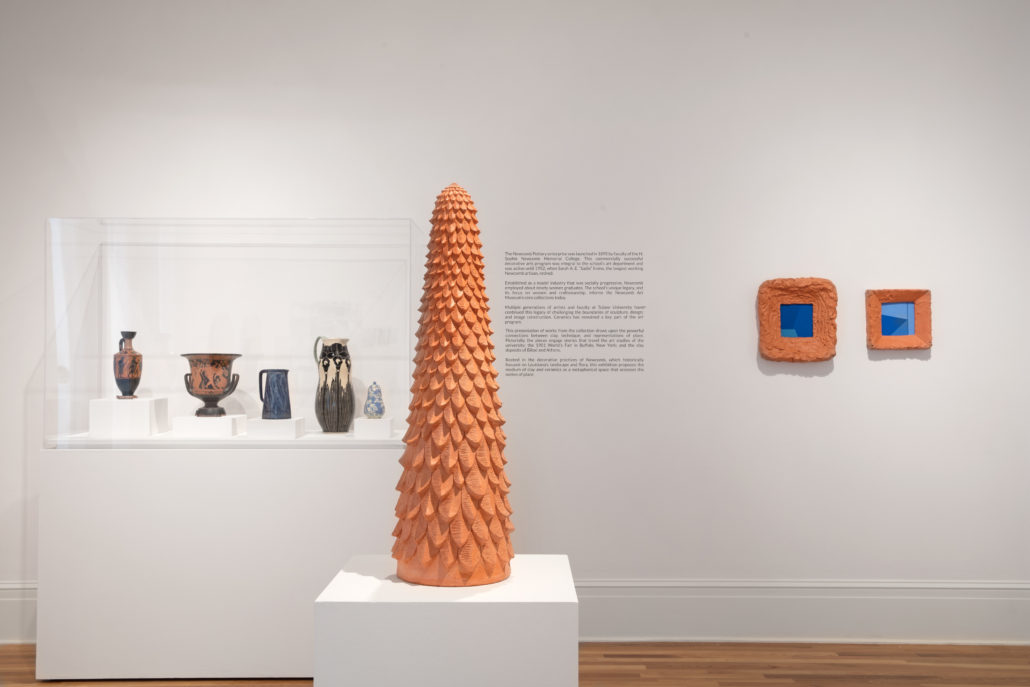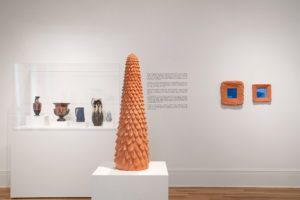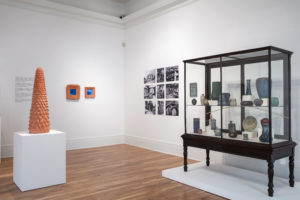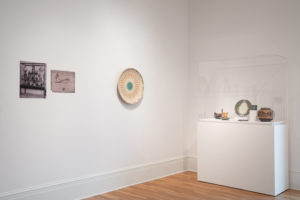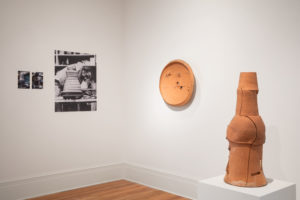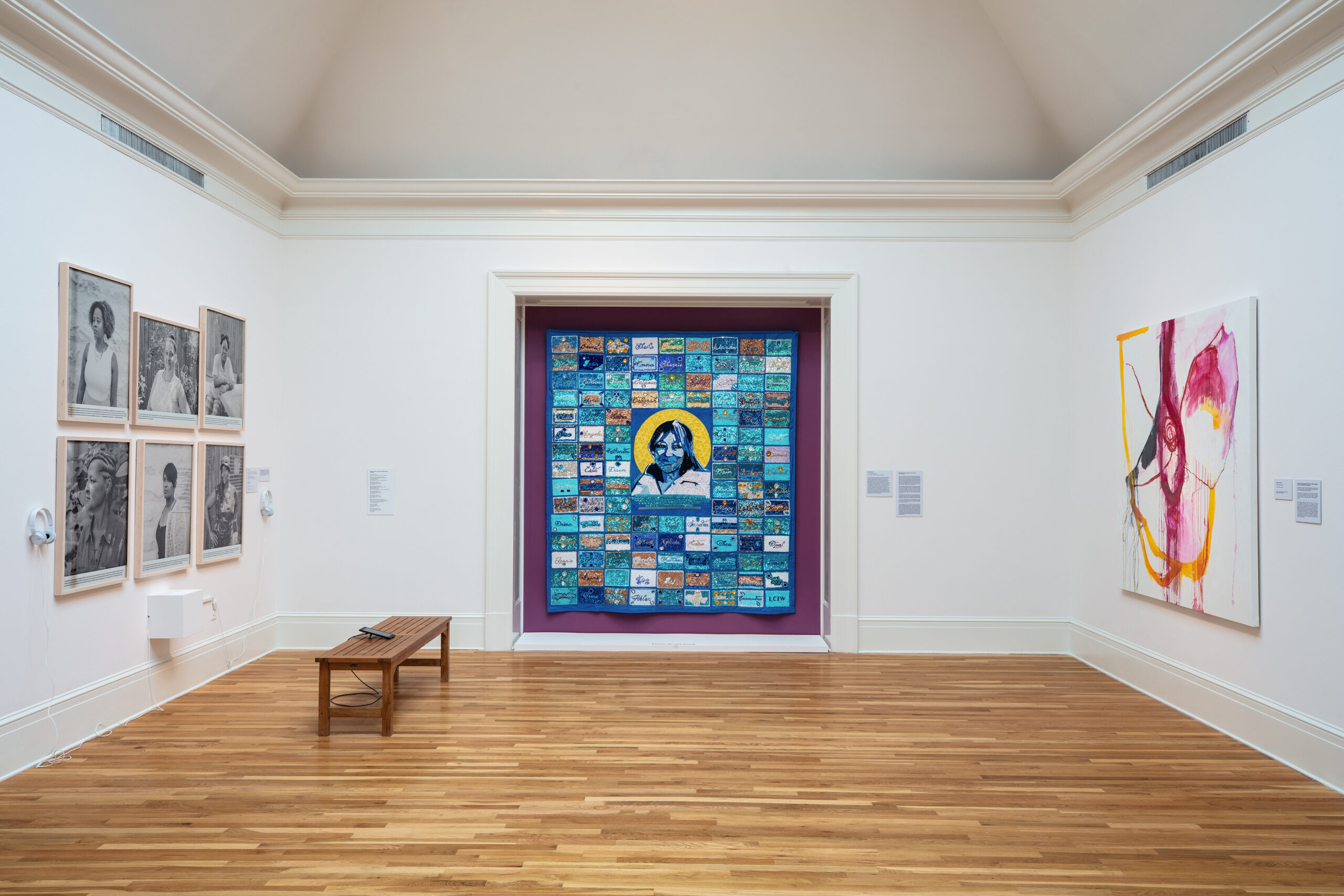Clay in Place:
Highlights from the Collection
- DurationJanuary 18 – March 24, 2018
- Curated byLaura Blereau
Since primeval times, clay has persisted as a medium explored by visual artists across the globe. Earthen materials, which are a springboard for the contemporary works by Mexican artists in the companion exhibition Clay in Transit, also have a local history and one particular to New Orleans: Newcomb Pottery (1895-1940).
Yet long before Joseph Meyer experimented from 1896 to 1927 with clay recipes for Newcomb pottery, clay was an ubiquitous material in New Orleans. The mud of the Mississippi River was a source for the characteristically soft red bricks found in the city’s home constructions. And, alluvial deposits in St. Tammany parish, near Lake Pontchartrain, yielded slightly harder paving bricks, recognizable even today in the sidewalks of the Garden District.
Historically, the pottery produced at Newcomb relied on clay from these two places as well as the Bayou Tchulakabaufa in Biloxi. Instead of a single source, terra cotta was created from a mixture of red and buff clays. Experiments with regional materials were conducted throughout the years, and clay for the pottery also occasionally came from coastal Alabama, Kentucky, South Carolina, New Jersey, and Indiana.
While much has changed stylistically since the post-war period when the medium of ceramics shifted toward non-functional approaches, clay has endured as a material that reflects its concurrent environment and milieu. The museum’s collection mirrors these shifts in style, and the exhibition Clay in Place highlights both traditional and contemporary ceramics and their different approaches to function and place.
Works on view include Newcomb Pottery (1895-1940) and Newcomb Guild (1940-1952), and recent pieces by selected alumni, faculty, and former faculty. Among the dozen-plus artists featured are pioneering clay sculptor Peter Voulkos, who conducted a workshop on campus in 1978; jewelry designer Mignon Faget; four former heads of the ceramics program, Katherine Choy, Sadie Irvine, Mary Sheerer and Ellsworth Woodward; co-founder of Studio in the Woods, Lucianne Carmichael; and Rachael DePauw, winner of the 2007 Jaunita Gonzales Prize in Ceramics.
_____
This exhibition is made possible through the generous support of Jennifer Wooster (NC ’91), Lora and Don Peters (A&S ’81), Newcomb College Institute of Tulane University, Ms. Valerie A. Besthoff, Andrew and Eva Martinez, and the Newcomb Art Museum advisory board.
About the Artists
Aurelia Coralie Arbo (b. 1909, New Orleans, LA; d. 1993) trained at Newcomb from 1927 to 1931 and earned a Bachelor’s of Design. Afterward, she worked at the pottery until 1940, as well as in the private business of Newcomb potter Paul Cox from 1939-1942 in Harahan. In 1943 she was hired by the New Orleans Public School system as an art teacher in the Eleanor McMain Secondary School and the L. E. Rabouin Vocational High School.
Henrietta Davidson Bailey (b. 1874, New Orleans, LA; d. 1950, New Orleans, LA) was affiliated with Newcomb College for more than three decades. Starting as an art student in 1901, Bailey went onto to earn her masters in 1905 and won a competitive scholarship to study with Arthur Dow in Ipswich, Massachusetts that same year. Afterward, she worked as Newcomb pottery designer until 1926, at which point she was invited to join the school’s art faculty, where she remained until retirement in 1938. In addition to her work a designer, Bailey also created woodblock prints featuring Louisiana landscapes.
Lucianne Carmichael (b. 1931, Toronto, Canada; d. 2016) was an award-winning potter and a principal of the McDonogh 15 Elementary School in New Orleans. She also was a co-founder of the artist retreat center A Studio in the Woods, which is managed by the ByWater Institute through the Office of Research at Tulane University.
Katherine Choy (Choy Pau Yu) (b. 1927, Shanghai, China; immigrated 1946 to the US; d. 1958, Port Chester, NY) succeeded Sadie Irvine as the head of the ceramics program at Newcomb in 1952. Unfortunately, only six years later, Choy died suddenly at age 29 of undiagnosed pneumonia. She held the post in New Orleans at Newcomb for five years before establishing the Clay Art Center in 1957 in Port Chester, New York. Still in operation today, this non-profit encourages advanced study of the ceramic arts. “As a young Chinese art student and immigrant to America, Katherine Choy quickly assumed the technical and aesthetic influences of two of the most accomplished ceramic artists of the previous decade in California, Carlton Ball and Anthony Prieto,” says American ceramics expert Ronald Kuchta. “More like a poet than a potter, her career was brief but brilliant in its own determined direction.” Groundbreaking for its day, particularly as a woman ceramicist, Choy’s work aesthetically merged the formalist influences of abstract expressionism with traditional calligraphic brushwork of Asian potters. In 2000, a solo exhibition of her work was featured at the Newark Museum in New Jersey. She earned a BFA and MFA from Mills College in Oakland, CA, in addition to further education at Wesleyan College in Macon, GA, and the Cranbrook Academy of Art in Bloomfield Hills, MI.
Rachael DePauw (b.1984, St. Louis, MO; lives in New Orleans LA) is an artist and educator who runs her own pottery and teaches at the Isidore Newman School. She earned a bachelor’s in Political Economy from Tulane University in 2007 and was one of the last students who was also able to receive an official degree from the H. Sophie Newcomb Memorial College. Upon graduation, the Newcomb Art Department also awarded her with the Juanita Gonzales Prize in Ceramics. DePauw apprenticed with Alex Williams at Potsalot Pottery in New Orleans. In her work, DePauw creates bold relief patterns and uses design motifs that reference Louisiana’s indigenous flora. Employing a technique called sgraffito, she paints a thin layer of black, liquid clay on a pre-fired vessel, and then uses a tool to carve through the slip to reveal the white clay underneath. The linear and abstract patterns created reflect New Orleans’s unique landscape and reference the blue and greenish wares of the Newcomb Pottery. Conceptually, her work also makes an important connection to the Newcomb artists who used sgraffito over a hundred years ago, such as Maria de Hoa LeBlanc and Harriet Joor.
William DePauw, Jr. (b. 1972, Warren MI; lives in New Orleans LA) is a Senior Professor of Practice in Ceramics at Tulane University. He earned a BFA in painting from Northern Michigan University and graduated from the Tulane MFA program in ceramics in 2004. DePauw’s work is rooted in a very personal observation of objects as abstract form. In his words, “I’m interested in how inherent references to the familiar or material can place the objects that I make into contexts, histories, and various other narratives.”
Mignon Faget (b. 1933, New Orleans LA; lives in New Orleans LA) is a celebrated artist and designer who creates jewelry pieces that reflect her native environment. In 1955 she earned a BFA in sculpture from Newcomb College, where her professors included Sarah “Sadie” Irvine, Robert Durant “Robin” Feild, Jules Struppeck and Pat Trivigno. She also studied at the Academie de la Grande Chaumiere in Paris, Parsons School of Design in New York, and St. Mary’s Dominican College in New Orleans. Now operating on Magazine street, she opened her first design shop in 1969.
Francis A. Ford (b. 1916, New Orleans LA; d. 1984) was active as a potter at Newcomb from 1933 to 1948. As a child, he studied with Juanita Gonzales at the Kingsley House in the Irish Channel neighborhood of New Orleans. In his teenage years, Ford attended Saturday ceramics classes at Newcomb and studied with Jonathan Hunt. After working part-time as a potter for the Newcomb Pottery, he began working full-time in 1945 with the Newcomb Guild. In 1948 he moved to Seattle where he was a ceramic technician for the University of Washington School of Engineering. Ford also worked for Boeing, North American Aviation, and Tektronix.
Jules Gabry (b. circa 1850; d. 1897) was the first potter at Newcomb and was active for two to three years, starting in 1894. Little is known about his life, but prior to coming to New Orleans, he worked with the Clément Massier Pottery in Golfe-Juan France. Gabry was a friend of ceramicist George Ohr and committed suicide near his home in Biloxi by drowning in the Mississippi River.
Juanita Louise Gonzales (b. 1903, New Orleans LA; d. 1935) was an artist born to a Spanish father who was raised in Cuba before immigrating to the US. She attended the teacher’s program at Newcomb from 1921 to 1925 and earned a Bachelor’s of Design. Afterwards, she studied in New York with Russian sculptor Alexander Archipenko. In 1931 Gonzales joined Newcomb’s arts faculty and returned to New Orleans, where she also taught design at the Arts and Crafts Club. Her artistic practice included a wide range of media, as well as pottery, and she created notable portrait busts of several Louisiana state governors. Gonzales also designed furniture, fixtures, and architectural ornaments.
The Gela Painter (active in Greece circa 510 to 490 BCE) was a prolific artist in ancient Greece whose distinctive style is recognizable, although his real name is not known. He painted lekythoi vases in the black-figure style native to the Attic Peninsula, at the site of present-day Athens. In his work, the Gela Painter is known for creating original compositions that primarily depicted mythological scenes. Gela is located in the Sicily region of Italy, and it likely that this artist’s work was traded overseas from Greece for use in tombs. In the 1950s, English scholar Sir John Beazley established a classification system for this painter, among other artists and workshops producing ancient vessels in the Mediterranean. Over several decades, Beazley’s attribution work was based on visually identifying an artist’s (or group’s) individual style.
Jane Irwin Gibbs (b. 1881, MS; died 1974, Long Beach, CA) attended Newcomb and graduated in art before moving to California, where she worked in public schools for several decades.
Jonathan Hunt (b.1876; d. 1943) was trained in the Fulper Pottery at Flemington, New Jersey and worked with Rookwood Pottery in Cincinnati and Orlando Pottery in Orlando. After the retirement of Joseph Meyer, Hunt came to Newcomb College as a ceramic chemist in 1927 and remained until 1933. He was a ceramic demonstrator of the Haeger Potteries of Dundee, Illinois at the Century of Progress Fair in Chicago in 1934-1935. He also worked at Broadmoor Pottery Company in Denver and was a consultant to several potters. He died November 12, 1943. (Excerpted from Newcomb Centennial, 1886-1986: An Exhibition of Art by the Art Faculty by Judith H. Bonner, exhibition catalog, published by Newcomb College, Tulane University, 1986, p. 31)
Sarah Agnes Estelle “Sadie” Irvine (b. 1887, New Orleans, LA; d.1970, New Orleans, LA) was raised in a small Catholic family in Uptown New Orleans. An artist and educator, she is considered by many scholars to be the leading figure in the influential Newcomb Pottery movement. The 1906 Newcomb College graduate taught pottery, design, and watercolor at the school until her retirement in 1952. Mentored by Ellsworth Woodward, Irvine designed many vases with oak, moss, and moon motifs, drawn directly onto the clay shape with perfect eye-measured width and modernist abstract aesthetics. Irvine’s craftsmanship is particularly evident in Newcomb’s geometric-based Espanol designs, inspired by odd patterns Ellsworth discovered in a hand-carved Spanish mantel in the French Quarter. (Excerpted from “Sadie Irvine” by Staff of the Louisiana Endowment for the Humanities, appearing in knowlouisiana.org Encyclopedia of Louisiana, edited by David Johnson. Article published September 12, 2012. http://www.knowlouisiana.org/entry/sadie-irvine.)
Harriet Coulter Joor (b.1875, Navarro County, TX; d. 1965) was an artist, designer, and educator who was an early graduate of the Newcomb program. She received a Bachelor’s of Science in 1895 and went on to continue her studies of art and teaching from 1896 to 1901. She was among the first three students in 1900 to win a summer school scholarship for school study with Arthur Dow in Ipswich MA. A Newcomb designer until at least 1906, Joor then moved to Chicago and, later, Washington D.C. As a professional designer, Joor created many of the needlework household textiles sold by the American Arts and Crafts impresario Gustav Stickley, in addition to Newcomb Pottery designs. She was also the author of many influential magazine articles that encouraged American women to explore handicrafts. Joor’s father was a botanist and on faculty at Tulane University, which influenced her attention to the visual details of local flora and fauna.
Images
Katharine Kopman (b. 1869, New Orleans, LA; d. 1950) earned her Diploma in Art from Newcomb College in 1895 and was a member of the first pottery decoration class which opened in the Fall of that same year. She was a graduate art student from 1896 to 1898, and taught from 1896 as an Instructor in Drawing. In 1907, as the program began to be more defined, she became an Instructor in Drawing and Design. As a Supervisor of Cadets in 1909, she assumed charge of students enrolled in education, and taught in the High School. In 1913 she was made Supervisor of Practice, responsible for both special and Normal students. In 1918 Kopman became Supervisor of Art at Alexandria Grammar School in Alexandria, Louisiana and also taught at Louisiana College in Pineville. She exhibited pottery at the 1915 Panama-Pacific International Exposition in San Francisco and a series of Red Cross posters in November of 1917. (Excerpted from Newcomb Centennial, 1886-1986: An Exhibition of Art by the Art Faculty by Judith H. Bonner, exhibition catalog, published by Newcomb College, Tulane University, 1986, p. 34)
Marie de Hoa LeBlanc (b.1874, New Orleans, LA; d. 1954, New Orleans, LA) and her older sister, Emilie, were both Newcomb artisans whose work was part of the enterprise’s first public exhibition in 1897. LeBlanc graduated from the school’s Normal Art Program in 1898, and the following year was listed as a Graduate Art Student. In 1902 the Newcomb faculty awarded LeBlanc with a scholarship to attend Denman Waldo Ross summer course “Theory of Design: Lectures, with experimental practice, for designers, for teachers of Design, and for teachers of the History of Art” at Harvard University. Although her active dates as a decorator at Newcomb Pottery lasted only about a decade, she continued to be very involved with the arts of her hometown until her death in 1954. (Excerpted from “Marie de Hoa LeBlanc and Early Designs” by Adrienne Spinozzi, appearing in the Stickley Museum Notes from the Farm Newsletters, Summer 2016 and Fall 2016.)
Cynthia Pugh Littlejohn (b. 1890, near Napoleonville, LA; d. 1959, New Orleans, LA) attended Newcomb with her lifelong friend and neighbor Sadie Irvine. They both received a Diploma in Art the year of 1906, and their graduating class of nine has been noted by historian Jessie Poesch as yielding “one of the most talented and productive group of artisans in the Art School’s history.” Afterward, Littlejohn continued her studies in graduate school at Newcomb and received a 1908 travel scholarship. She also took courses at Columbia University in New York during the summer of 1910. In addition to pottery, Littlejohn created work in leather and leaded glass. Her pieces were included in the Panama-Pacific International Exposition in San Francisco in 1915.
Ada Wilt Lonnegan (b. 1879, New Orleans, LA; d. 1963, New Orleans, LA) was an early graduate of the Newcomb program. She enrolled in 1896 and received a Diploma in Art in 1900, before completing her graduate studies in 1901. Lonnegan specialized in calligraphy, drawing and pottery design. Her work was exhibited in 1904 in St. Louis at the Louisiana Purchase Exposition.
Ruth Maddox (active at Newcomb 1927 – 1930, d. 1966) received a Bachelor of Design from Newcomb, where she specialized in silversmithing, pottery, and wallpaper design. Her sister was Floy Maddox, another Newcomb artisan, whose papers are part of the Special Collections of Tulane University.
Joseph Fortune Meyer (b. 1848, Buthiers, Haute-Saône, France; d. 1931, New Orleans, LA) was a key figure of the Newcomb Pottery movement and helped build the pottery’s kilns. His stamped mark is visible on more pieces than any other single artisan in the group. He was also a mentor to ceramic artist George Ohr, “The Mad Potter of Biloxi”. Born in Alsace-Lorraine, France, Joseph Meyer grew up in Biloxi, Mississippi, learning the potter’s trade from his father. He eventually maintained his own pottery business in New Orleans before working at the Pottery Club of New Orleans from 1886 until 1890. In 1896 Meyer was called by Ellsworth Woodward to help set up the Newcomb pottery enterprise. From then until 1927 Meyer threw, glazed, and fired all the ware decorated by the women at the Pottery. He was an extremely skillful potter who could throw and trim virtually any shape or form requested by the decorators. Always active, he experimented with a number of clay bodies and glazes including copper-reds. (Excerpted from 100 Years of Ceramics at Newcomb College, 1894-1994. A Faculty Retrospective by Jeremy Jernegan, Jessie Poesch, and Tiffany Sherman, exhibition catalog, Newcomb Art Department, 1994, p. 11.)
Leona Fischer Nicholson (b. 1875, St. Francisville, LA; d. 1966) was an artist, educator, and ceramicist who specialized in tiles. She earned a Diploma in Art from Newcomb in 1901 before continuing the pottery program at the graduate level and earning a master’s degree. An active Newcomb artisan until 1929, she also attended Alfred University and was recognized by the Boston Society of Arts and Crafts. Nicholson also developed glazes and hand-built pieces as an independent ceramicist, at the encouragement of her mentor, Mary Given Sheerer. Later in life Nicholson founded and directed the ceramics program at the New Orleans Jewish Community Center on St. Charles Avenue, where she worked from 1941 for nearly two decades until her retirement.
Mary Given Sheerer (b. January 1865; d. 1954, Cincinnati, OH) was trained in the fine arts at the Cincinnati School of Art, which was strongly influenced by the English Arts and Crafts movement, and was also a pupil of the Art Students League in New York. Her primary experience and interest was in design and “industrial arts” and therefore, she was the perfect candidate to help establish the Newcomb Pottery. She arrived in 1894 to teach pottery design and supervise the decoration of the pottery at Newcomb College. Working closely with potters Jules Gabry and Joseph Meyer, Sheerer was primarily responsible for establishing a successful studio, making use of locally available equipment, clays, and glaze materials. As the professor of Pottery and China Decoration, her aesthetic strongly influenced the shape and character of the Newcomb ceramics program for almost forty years. (Excerpted from 100 Years of Ceramics at Newcomb College, 1894-1994. A Faculty Retrospective by Jeremy Jernegan, Jessie Poesch, and Tiffany Sherman, exhibition catalog, Newcomb Art Department, 1994, p. 8.)
Erin “Effie” Shepard (b. 1883, New Orleans, LA; d.1917) attended Newcomb as a Normal Art student from 1900-1903 when she received a Diploma in Art. She was enrolled as a Graduate Art student between 1903 and 1909. She joined the ranks of Arts Craftsmen from 1910-1913. An award-winning watercolorist, Miss Shephard also distinguished herself in the fields of pottery decoration and metalwork. (Excerpted from Newcomb Pottery by Jessie Poesch, Schiffer Publishing Ltd.,1984, p. 104)
Anna Frances “Fanny” Simpson (b. 1880, New Orleans, LA; d. 1930) received a Diploma in Art from Newcomb College in 1906 and earned her Master’s degree in 1908. Afterward, she was employed by the Pottery over two decades, until 1929, shortly before her death. In 1930, a solo exhibition of her work was featured posthumously at the Museum of Fine Arts Houston.
Kenneth Eugene Smith (b. 1907, d. circa 1980) joined Newcomb in 1929 to supervise the technical direction of the pottery and remained on faculty until 1946. He was a ceramic chemist and pottery instructor who, after Jonathan Hunt’s departure in 1933, also became a potter for Newcomb Pottery and Newcomb Guild – the latter of which he helped establish in 1942 with a proposal to Tulane’s Board of Administrators. From 1943-1945 he also taught in the Tulane College of Engineering. Hunt later worked for the US State Department in Honduras, where he helped establish and became faculty at the La Escuela Nacional de Nella Artes in Tegucigalpa. In 1946, Smith moved to Indianapolis where he worked for the American Art Clay Company until his retirement in 1974. An editor for Ceramics Monthly more than twenty years, he was also a member of the American Ceramic Society, the National Institute of Ceramic Engineers, and served as a past president of the Southeastern Art Association. Smith earned a BS in ceramic engineering at Alfred University in New York in 1929 before continuing on to graduate school at Ohio State University, where he earned an MFA in 1939 based on three years of Summer study.
Jeffrey Thurston (b. 1984, Sacramento, CA; lives in New Orleans, LA) is a 2016 graduate of Tulane’s MFA program, and presently an adjunct professor teaching ceramics at Tulane. He holds a BFA from California State University, Chico, and also studied at Diablo Valley College in Walnut Creek, CA. Thurston grew up in the San Francisco Bay area, and his recent work is informed by an early memory of ships moored at the bank of the Carquinez Strait, near the Benicia-Martinez bridge. The objects he creates bear a physical reference to the instability of traveling by sea, while also more broadly representing the notion of a watertight ceramic vessel, and the archaeological significance of pottery fragments that can surface over time. “A lot of my practice deals with a sense of uneasiness,” says the artist. “I don’t think I’ve ever felt totally at ease at any one place.” While living in California he recalls, “I was just inundated with [Peter] Voulkos’s work, so 3D-wise, that’s where I get a lot of influence … there’s a roughness and a rawness that he uses. I’ve been trying to capture that in my own work.”
Lauren “Lola” Victor (b. 1993, San Diego, CA; lives in Europe) is a 2016 graduate of Tulane’s BA program. She studied Studio Art and English Literature, with a special interest in Gender and Sexuality Studies. She complemented her education in New Orleans with further training at the Studio Art Centers International in Florence, Italy, where she also worked with the Museum of Anthropology to help create a digital archive of 19th-century photographs from Italian anthropological expeditions. Primarily using ceramics in her art, Victor creates socially conscious work that explores notions of “the body and identity, using history as a lens”. In 2017 Victor lived in Italy and Austria, working for the European Cultural Centre for the Venice Biennale, and the Urhof20 international performance art festival in Grünbach Am Schneeberge, near Vienna. She is presently based abroad and most recently traveled to Israel. This fall, she anticipates the start of her graduate studies at the Royal College of Art in London, where she will focus on ceramics and glass.
Peter Voulkos (b. 1924, Bozeman, MT; d. 2002, Bowling Green, OH) is among the most influential figures of American ceramics. Voulkos created sculpture that elevated the medium of ceramics to “new levels of abstraction and personal expression,” in the words fo The New York Times arts writer Roberta Smith. Following a 1953 summer teaching post at Black Mountain College, where he befriended Franz Kline, Voulkos founded two important ceramics departments on the West Coast: first in 1954 at the Los Angeles County Art Institute, now known as the Otis College of Art and Design; and next in 1959 at the University of California at Berkeley, where he remained on faculty until 1985. While on sabbatical, Voulkos was invited to present an artist lecture and demo in New Orleans at Tulane University. His visit occurred in the Spring 1978 semester, from February 28 through March 3, and it accompanied a three-week solo exhibition in the space now known as the Carroll Gallery. His visit was sponsored by the then recently established Alumni Visiting Artists Program, which was founded by two 1965 Newcomb graduates, Patty Whitty Johnson and Mary Sue Nelson Roniger. Voulkos earned a BS in Painting from Montana State University and an MFA in 1953 from the California College of the Arts and Crafts in Oakland. In 2016 a solo exhibition of his work, “Voulkos: The Breakthrough Years,” opened at the Museum of Art and Design in New York and traveled in 2017 to the Smithsonian’s Renwick Gallery in Washington DC.
Sabina Elliot Wells (b. 1876, Charleston, SC; d. 1943, Hoopers Creek, NC) created some of the Newcomb Pottery’s most impressive pieces, though she was not with the enterprise for long. She enrolled for one session, 1902-1903, as a Special Art student. The following sessions, 1903-1904, she was listed in the Pottery Design class. Her boldly incised motifs show both close observation of nature and a strong sense of design. Three examples of Well’s work were shown in at the Louisiana Purchase Exposition held at St. Louis in 1904; a vase with incised water lily design a plate with a shrimp design, and a vase with incised design of lioness. Though she had left Newcomb some years before, examples of her work, no doubt those retained in the College collection, were shown in the Newcomb exhibits at the Panama-Pacific International Exposition in San Francisco in 1915. The papers of artist, designer, and book illustrator Sabine Elliott Wells are held by the South Carolina Historical Society in Charleston. (Excerpted from Newcomb Pottery by Jessie Poesch, Schiffer Publishing Ltd.,1984, p. 106)
Ellsworth Woodward (b. 1861, Seekonk, MA; d. 1939, New Orleans, LA) was a teacher, artist, promoter and pillar of the New Orleans art scene between 1890 and 1940. He painted in an impressionist style all his life but, though his work was popular, his primary influence was as teacher and institution builder. He is particularly known as one of the founders of Newcomb Pottery at Sophie Newcomb College (now part of Tulane University) in New Orleans. A proponent of the Arts and Crafts movement, popular in the late nineteenth and early twentieth centuries, Woodward advocated local crafts as an alternative to standardized, machine-made wares … Educated at the Rhode Island School of Design, Ellsworth also studied abroad briefly in Munich, under Carl Marr and Richard Fehr … During his long career, Woodward promoted his aesthetic idealism through substantial organizational service. In 1900, he established the New Orleans Art Association. Twelve years later, he chaired the art committee at the newly established Isaac Delgado Museum of Art (now the New Orleans Museum of Art) and became its president in 1924. In 1920, he cofounded the Southern States Art League, over which he presided from 1926 to 1933. But the pottery he established on the Newcomb campus in 1895 remains both his longest and best-known attempt to institutionalize his vision of art and society. (Excerpted from “Ellsworth Woodward” by Richard Megraw, appearing in knowlouisiana.org Encyclopedia of Louisiana, edited by David Johnson. Louisiana Endowment for the Humanities, 2010–. Article published January 21, 2011. http://www.knowlouisiana.org/entry/ellsworth-woodward.)

